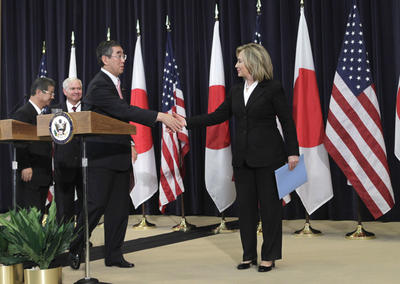Though overshadowed by the 3/11 tragedy, as well as the shenanigans of the political classes in Tokyo, the joint statement — and updated ‘common strategic objectives’— constitutes a robust reaffirmation of the essential Article V and Article VI bargain within the US–Japan security arrangements, which underpins the defence of Japan and the forward-deployed American presence in East Asia.
The ‘common strategic objectives’ in the February 2005 2+2 Joint Statement, as well as the Japanese National Defense Program Guidelines passed two months earlier, provide a useful reference point to assess the current 2+2 statement. At the time, the 2005 statement served to reinforce the intent of the then recently issued Defense Guidelines: to extend alliance cooperation. The view was to make Japan an active contributor to ‘international peace cooperation activities’ of unlimited geographic reach, which had been added in the Guidelines as a primary mission of the Self Defence Forces (SDF). By 2007, broader Japan–NATO cooperation had also been added to the list of common strategic objectives.
By contrast, the 2011 joint statement contains no such spirited call to take the US–Japan alliance global. Shadowing the retreat in Tokyo’s security horizons to primarily the defence of its homeland and immediate neighbourhood — spelt out in the December 2010 Defense Guidelines — ‘out-of-area’ peacekeeping, humanitarian aid and disaster relief activities are de-emphasised in this 2+2 statement. Instead, operationally-sound trilateral security and defence frameworks with Canberra and Seoul to maintain peace and security in the Asia Pacific region are emphasised. Abstract and impractical pan-Asian strategic architectural designs have been dispensed with. Caution is exercised in not extending formal security obligations to the South China Sea area, as well as to cover regional sea lines of communications therein – even as a defense of navigational freedoms and strengthened cooperation with ASEAN states is advocated.
An equal degree of sobriety and realism is evident in the alliance’s present deterrence planning with reference to China and Taiwan. The 2005 2+2 Statement was the first official alliance document since the 1969 Nixon–Sato Communiqué to reference a joint strategy towards China. The 2011 statement continues in this vein but, like the 2005 Statement, uses less-confrontational language than 1969 with regard to Taiwan.
In a further nod to discretion, East China Sea dispute contingencies are not specifically referred to. It bears remembering in this regard that explicit reference to strengthening the defences of Japan’s south-western (Okinawan) island chain were a notable innovation within the recent Defense Guidelines. That said, tailoring operational capability to overcome Chinese anti-access/area-denial strategies so as to maintain a stable deterrence is underscored in the joint statement.
Going forward, a question mark hangs over whether the ‘common strategic objectives’ will translate into a revised — and convergent — set of roles and mission responsibilities within the bilateral security arrangements. The 2005 Statement had provided a critical departure point for identifying a conceptual set of transformative, future-oriented alliance initiatives. It also acted as a catalyst for a restless energy within incumbent, anti-mainstream conservative forces in Tokyo. These groups, in seeking to progressively blur definitional lines between conflict and post-conflict activities, as well as operations conducted in military and policing mode, had sought to effect revisionist interpretations of Japan’s constitution.
By contrast, the current 2+2 statement relegates the revisionist aspects of these roles and missions debate to abeyance. It imposes no Japanese obligation, and entails no commitment, to revise or reinterpret the legal/constitutional framework of its security policy. While the 2+2 statement invokes the importance of cooperating in humanitarian relief activities, liberalised weapons-use rules are not foreseen. While the importance of cooperating in peacekeeping and anti-terrorist operations is stressed, measures that authorise SDF participation in such missions beyond ‘non-combat zones’ is not expected. Similarly, while cooperation on ballistic missile defence (BMD) is re-iterated, Tokyo’s interception of such missiles destined beyond sovereign Japanese territory is not anticipated. That said, a further exception to its weapons-sales principles (Three Principles on Arms Exports) is provided for by Tokyo, so as to enable sales of jointly-developed BMD technologies to friendly third countries.
The 2011 ‘common strategic objectives’ reflects a serious and sober recommitment to the alliance’s fundamental purposes at a time of immense flux in the Asian order. While it is unlikely to satisfy the expectation of the ‘alliance supremacists’ or the ‘small Japanist’ pacifists, and glosses over the crushing burden on Okinawa’s unfortunate inhabitants, the 2+2 statement consolidates the significant political and operational alliance gains realised over the past decade. The Joint Statement, and the earlier Defense Guidelines, provides a useful window into the strategic worldview of the Democratic Party of Japan’s present leadership.
Sourabh Gupta is a Senior Research Associate at Samuels International Associates, Inc. in Washington DC, and a contributor to the East Asia Forum.

